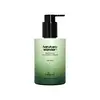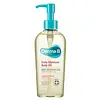What's inside
What's inside
 Key Ingredients
Key Ingredients

No key ingredients
 Benefits
Benefits

 Concerns
Concerns

 Ingredients Side-by-side
Ingredients Side-by-side

Water
Skin ConditioningGlycerin
HumectantHelianthus Annuus Seed Oil
EmollientCaprylic/Capric Triglyceride
MaskingHydrogenated Polyisobutene
EmollientPotassium Cetyl Phosphate
EmulsifyingDiisostearyl Malate
EmollientUrea
BufferingPentaerythrityl Tetraisostearate
Emollient1,2-Hexanediol
Skin ConditioningButylene Glycol
HumectantParfum
MaskingHydroxyacetophenone
AntioxidantStearyl Alcohol
EmollientCetyl Alcohol
EmollientGlyceryl Stearate
EmollientPrunus Amygdalus Dulcis Oil
Skin ConditioningSqualane
EmollientArgania Spinosa Kernel Oil
EmollientAcrylates/C10-30 Alkyl Acrylate Crosspolymer
Emulsion StabilisingXanthan Gum
EmulsifyingCalophyllum Inophyllum Seed Oil
AntimicrobialBambusa Vulgaris Water
Skin ConditioningStearic Acid
CleansingEthylhexylglycerin
Skin ConditioningPalmitic Acid
EmollientPhyllostachys Pubescens Shoot Bark Extract
Skin ConditioningDisodium EDTA
Tromethamine
BufferingPhyllostachys Nigra Leaf Extract
Skin ConditioningAspergillus Ferment
Skin ConditioningMandelic Acid
AntimicrobialMyristyl Alcohol
EmollientArachidic Acid
CleansingLauryl Alcohol
EmollientMyristic Acid
CleansingOleic Acid
EmollientCitronellol
PerfumingGeraniol
PerfumingLimonene
PerfumingCitral
PerfumingLinalool
PerfumingWater, Glycerin, Helianthus Annuus Seed Oil, Caprylic/Capric Triglyceride, Hydrogenated Polyisobutene, Potassium Cetyl Phosphate, Diisostearyl Malate, Urea, Pentaerythrityl Tetraisostearate, 1,2-Hexanediol, Butylene Glycol, Parfum, Hydroxyacetophenone, Stearyl Alcohol, Cetyl Alcohol, Glyceryl Stearate, Prunus Amygdalus Dulcis Oil, Squalane, Argania Spinosa Kernel Oil, Acrylates/C10-30 Alkyl Acrylate Crosspolymer, Xanthan Gum, Calophyllum Inophyllum Seed Oil, Bambusa Vulgaris Water, Stearic Acid, Ethylhexylglycerin, Palmitic Acid, Phyllostachys Pubescens Shoot Bark Extract, Disodium EDTA, Tromethamine, Phyllostachys Nigra Leaf Extract, Aspergillus Ferment, Mandelic Acid, Myristyl Alcohol, Arachidic Acid, Lauryl Alcohol, Myristic Acid, Oleic Acid, Citronellol, Geraniol, Limonene, Citral, Linalool
Ingredients Explained
These ingredients are found in both products.
Ingredients higher up in an ingredient list are typically present in a larger amount.
You may know this ingredient as argan oil. Argan Oil has antioxidant, hydrating, and soothing properties.
Studies have shown argan oil can help fight again radical damage from the sun. This makes it effective at preventing hyperpigmentation.
Large amounts of vitamin E found in argan oil helps the skin retain water. Argan oil also contains fatty acids such as linoleic acid, oleic acid, and palmitic acid. It is also a good source of lipids.
Another benefit of argan oil is skin-soothing. It can help reduce inflammation-related skin symptoms.
Argan Oil is effective at regulating sebum production in pores. This can make it effective at treating hormonal acne.
Traditionally, argan oil was used for its antibacterial and antifungal properties. However, argan oil contains fatty acids that may make it not fungal-acne safe.
Argan Trees are native to Morocco.
Learn more about Argania Spinosa Kernel OilThis ingredient is an emollient, solvent, and texture enhancer. It is considered a skin-softener by helping the skin prevent moisture loss.
It helps thicken a product's formula and makes it easier to spread by dissolving clumping compounds.
Caprylic Triglyceride is made by combining glycerin with coconut oil, forming a clear liquid.
While there is an assumption Caprylic Triglyceride can clog pores due to it being derived from coconut oil, there is no research supporting this.
Learn more about Caprylic/Capric TriglycerideHelianthus Annuus Seed Oil is the oil derived from the seeds of a Sunflower. Sunflower seed oil is non-fragrant. It is an emollient, meaning it helps to soften the skin.
Sunflower seed oil contains many fatty acids. The fatty acids found in sunflower seeds include (from highest amount to least): linoleic acid, myristic acid, palmitic acid, stearic acid, arachidic acid, oleic acid, and linolenic acid.
These fatty acids help the skin create ceramides. Ceramides play a role in repairing the skin barrier.
Helianthus Annuus Seed Oil helps moisturize the skin. This in turn helps the skin look more rejuvenated and smoother.
Sunflowers are rich in vitamin E.
Historians believe Indigenous cultures of North America domesticated sunflowers before corn. Thus they relied on sunflower oil for a variety of uses. One such use is moisturizing skin and hair.
Sunflower seed oil may not be fungal acne safe. We recommend speaking with a professional if you have any concerns.
Learn more about Helianthus Annuus Seed OilParfum is a catch-all term for an ingredient or more that is used to give a scent to products.
Also called "fragrance", this ingredient can be a blend of hundreds of chemicals or plant oils. This means every product with "fragrance" or "parfum" in the ingredients list is a different mixture.
For instance, Habanolide is a proprietary trade name for a specific aroma chemical. When used as a fragrance ingredient in cosmetics, most aroma chemicals fall under the broad labeling category of “FRAGRANCE” or “PARFUM” according to EU and US regulations.
The term 'parfum' or 'fragrance' is not regulated in many countries. In many cases, it is up to the brand to define this term.
For instance, many brands choose to label themselves as "fragrance-free" because they are not using synthetic fragrances. However, their products may still contain ingredients such as essential oils that are considered a fragrance by INCI standards.
One example is Calendula flower extract. Calendula is an essential oil that still imparts a scent or 'fragrance'.
Depending on the blend, the ingredients in the mixture can cause allergies and sensitivities on the skin. Some ingredients that are known EU allergens include linalool and citronellol.
Parfum can also be used to mask or cover an unpleasant scent.
The bottom line is: not all fragrances/parfum/ingredients are created equally. If you are worried about fragrances, we recommend taking a closer look at an ingredient. And of course, we always recommend speaking with a professional.
Learn more about ParfumPrunus Amygdalus Dulcis Oil comes from the sweet almond, a tree native to Iran. This oil has no fragrance and is non-volatile.
Almonds contain healthy fats, vitamins, and minerals. It is a rich source of Vitamin E, a great antioxidant and skin conditioning ingredient. Sweet almond oil contains fatty acids such as linolenic acid and triglycerides.
The content of sweet almond oil makes it a great emollient; it can help soften and hydrate your skin. Emollients create a barrier over your skin to trap moisture in. Sweet almond oil has antioxidant properties.
Those with an almond allergy should be careful of this ingredient and speak with a professional about using it in your skincare.
This ingredient may not be fungal-acne safe.
Learn more about Prunus Amygdalus Dulcis Oil